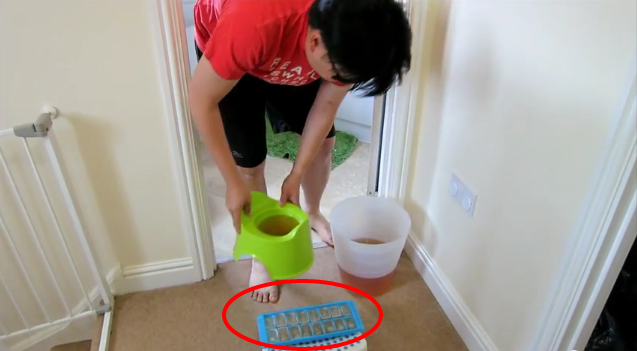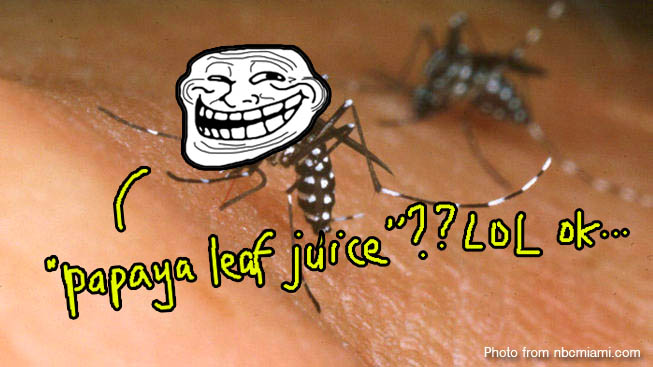1 Malaysian dies from dengue every day. Will vaccinations help?
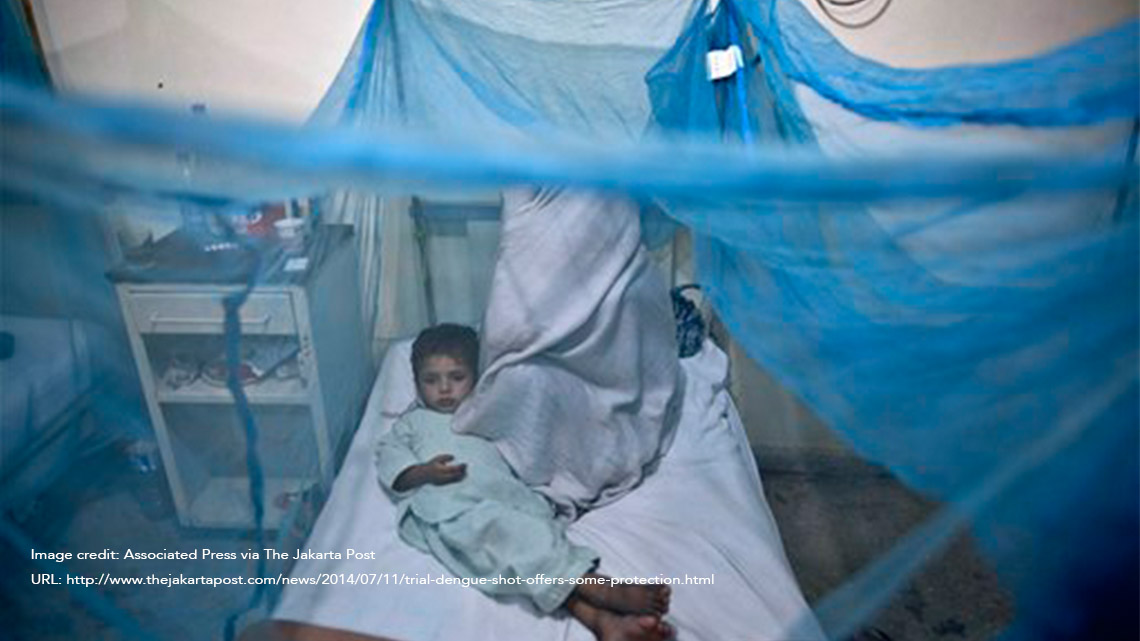
- 560Shares
- Facebook545
- Email1
- WhatsApp2

When this article was initially published in August 2014, dengue cases were at an all-time high with almost 60,000 cases and 110 deaths between January and August that year, with some sources claiming that it has reached “epidemic proportions“. Our dengue drama even earned us a little video segment on the BBC in September where it is mentioned that there are an average of 250 cases reported daily.
But flash forward to April 2015, how are we doing on the dengue front?
Worse, apparently. According to iDengue, a new (at least, it wasn’t around when we first wrote this article) nationwide portal to track Dengue cases; we’ve recorded 38,000 cases and 117 deaths from January 4th – April 22nd this year.
That is more than ONE DEATH A DAY, ugaiz!
Even while keeping in mind that some deaths might have been carried over from the previous year, we have reached almost 2/3 of the cases recorded till August last year, and we still have four months to go! If you’re feeling particularly geeky, morbid, or both; iDengue also has a daily case counter which breaks down cases by state every 24 hours.
What we’ve noticed is that every time a dengue panic happens, you’ll usually start hearing or reading expert proven advice on how to prevent it “because it’s been proven since your grandmother’s time”. With apologies to everyone’s grandmother, we decided to put all this “advice” through the acid test by running them through Professor Dr. Sazaly bin Abu Bakar of the Tropical Infectious Diseases Research and Education Centre (TIDREC) at Universiti Malaya.
So does papaya leaf help in curing dengue? Can we be vaccinated against it? Well let’s find out together-gether, starting with….
1. Eh, if you get bitten by the zebra mosquito sure kena Dengue already!
Well, this is an easy one. It’s totally untrue. The “zebra mosquito” is known as Aedes aegypti, identified by the white stripes on its legs.


While it’s true that they are responsible for spreading the dengue virus in this region, they don’t naturally carry it; meaning that they have to first acquire the virus from an infected host.
How do you know if you’re infected? Well…
2. I should probably go see a doctor when I start finding red spots on my skin.
No, no you shouldn’t.
You should definitely be heading to the emergency room at the nearest hospital because this is a sign of acute dengue fever. And trust us, by this stage, there’s nothing a-cute about it. Not even remotely a-dorable.
For reference, here’s the list of principle dengue symptoms courtesy of the CDC:
- High fever and at least two of the following:
- Severe headache
- Severe eye pain (behind eyes)
- Joint pain
- Muscle and/or bone pain
- Rash
- Mild bleeding manifestation (e.g., nose or gum bleed, petechiae, or easy bruising)
- Low white cell count
And here’s a list of acute symptoms:
- Severe abdominal pain or persistent vomiting
- Red spots or patches on the skin
- Bleeding from nose or gums
- Vomiting blood
- Black, tarry stools (feces, excrement)
- Drowsiness or irritability
- Pale, cold, or clammy skin
- Difficulty breathing
According to Prof. Sazaly, first-time dengue infections are generally milder but subsequent infections are more severe with a risk of developing a potentially-fatal dengue hemorrhagic fever.
During a first bout of dengue, the body’s immune system starts developing antibodies to combat the virus. Upon recovery, the body “remembers” how to fight this infection and is able to react more rapidly the next time it appears.
So why is a second infection worse?
Ironically, it’s this “memory” function that causes it. There are actually 4 strains of Dengue (we’ll explain more of that later) and this “memory function” only provides immunity from the type that caused the first infection. In a phenomenon called the “Antibody-dependent enhancement of infection,” being infected by a different serotype actually makes it worse as the antibodies help the virus infect the host cells more efficiently. We illustrate this with this easy-to-read infographic below or you can read up more about this here and here:
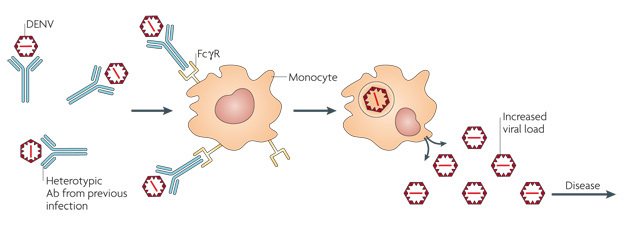
Oh by the way, did we say four dengue strains? We meant FIVE.
3. There is a new Dengue virus??? WE’RE ALL GONNA DIE!!!!!!
The good news is that there is no new dengue virus. In fact Prof. Sazaly says that it’s been “the same virus for the past 1,400 years.”
The not-so-good news is that while there isn’t a new virus, there’s a new serotype.

Don’t worry, we’ve got you covered. A serotype is a distinct variation within a species of bacteria or virus based on their cell surface antigens. Antigens are a substance that provokes an adaptive immune response in the immune system. Got it? Yeah, we didn’t either.
The best way we can explain this is a potentially wrong, potentially offensive way is by using an analogy we’re all familiar with: Racism. Each race (bacteria or virus) would have different subgroups (serotype) which would have some specific identifiable traits, such as larger noses or wider eyes (antigens). Some subgroups are disliked more than others -even within the race- so they may be discouraged from marrying or be called offensive names behind their backs (adaptive immune response) by old ladies in the morning market (immune system).
We apologize to all biologists reading this.
There are four serotypes that cause dengue fever, known as dengue virus 1, 2, 3, and 4 (There are other ways to refer to the types, but we will stick to this one) which are further divided into subtypes. This point becomes more important later.
And the new serotype? Well, it was discovered in Sarawak in 2013 and is circulating among Macaques.

Which is good news, since it’s not like we’re related to monkeys or anything

Yeah, there has been one case of a man being infected by this serotype in 2007, but it’s an isolated case with mild symptoms. So nothing to panic about.
Unless you’re working on a dengue vaccine, which brings us to…
4. Eh, don’t need to worry la. Now they have vaccine already!
Development for a dengue vaccine has been undertaken by numerous parties since the 1940s but it wasn’t till April 2014 that a French pharmaceutical, Sanofi, published Phase II clinical trial results that was deemed promising enough to make it to Phase III . In case you were wondering, here’s an FAQ on clinical trial phases.
So that’s great right? Like, give them a couple more years and the world would be dengue-free? Right?
Right?
For one, it took them 20 years of research to reach Phase III. If testing goes well, they will be able to obtain a license by 2015 (which they seem pretty confident in doing, since they have already started building a production facility capable of producing 100 million doses a year), otherwise the couple more years may be slightly extended to a couple more decades.
Also, remember how we mentioned that there were four dengue serotypes and how this would be important? Well, that’s for this part:
The vaccines offer differing protection for each serotype – 75 percent for Dengue 3 and 4, 50 percent for Dengue 1, and 35 percent for Dengue 2.
All four serotypes have been observed in Malaysia, with each taking precedence at different times over different locations. Prof. Sazaly mentions that Dengue 1 is the most prevalent serotype, with Dengue 2 in the background.
In fact, one of the reasons given for this current outbreak is the change in Dengue serotype prevalence from Dengue 4 to Dengue 2. But what does this have to with the vaccines?
Well, remember how we mentioned the “Antibody-dependent enhancement of infection”? Prof. Sazaly says that if you’ve not had Dengue before and if the vaccine doesn’t work, you’ve just got your first Dengue infection. If you factor this point along with the findings that the vaccine works better with adults compared to children, and with the success rates reported; is it worth the risk?
(Note: We’re not pulling a Jenny McCarthy and saying that vaccines are evil placebos. We’re saying that an informed decision from both sides of the fence is better than blind faith.)
5. I heard Government using mutant mosquitoes to combat Dengue? This is like Terminator wei! Useless government!
Totally untrue. The Terminator franchise is an allegory about Man bringing about His own downfall due to greed and reliance on technology. What you’re probably thinking about is Resident Evil, which is an allegory about Man bringing about His own downfall due to greed and disrespect for nature.
But the Malaysian government did conduct a trial study of genetically modified (GM) mosquitoes though.
*cue dramatic music*
In 2010, the Institute of Medical Research (IMR) released a variant of GM mosquitoes called OX513A into a forest in Bentong in a controlled study…

Developed by a British bioengineering firm called Oxitec, OX513A are male mosquitoes engineered to mate with female mosquitoes and produce offspring that die unless grown in an environment rich in tetracycline, an antibiotic. Oh and if you didn’t notice in the picture above, they glow. You can read more about how they’re created here.
So basically, more dead offspring = less mosquitoes = no Dengue. Here’s an infographic from the IMR detailing this process in scientific detail:

The results of the Bentong study have yielded satisfactory results. We note that this is our interpretation of the published results but you can make your own conclusions by reading the full report here (Warning: Not Safe for Brain)
A second study is to be conducted in Alor Gajah, but as of November 2013, it’s still awaiting approval for regulatory requirements.
By this time you might be wondering what the impact of these GM mosquitoes are. Well, for one thing, you probably don’t wanna get bitten by a GM mosquito. There might also be unseen environmental concerns from eradicating a native species, and this may also allow other species of disease-carrying mosquito to move in.
The success of this method in a real-world setting has also been doubted in an independent study using a formula we’ve screencapped below:

Also, Aedes aegypti isn’t a good transmitter for Dengue viruses present in monkeys, but some other Aedes subspecies are. Remember the 5th serotype?
We contacted the Department of Biosafety to find out more about these concerns, and if trials are still ongoing. They have been nice enough to provide us with a fact sheet, an document with the approval to conduct the trial, the risk assessment report, and a Q&A document which will take forever to go into detail here, but it makes some pretty interesting reading.
Questions about the trial and other methods being considered by the Health Ministry were redirected to the IMR, and we have yet to receive a reply at the time of writing. However, we did come across a news article in mentioning that the government “has yet to make a final decision” in deciding whether or not to release them to the open environment.
Since Brazil has okayed the release of OX513A in some public areas we can just wait and see what happens. In the meantime, we’ll just keep fogging.
6. The government never fog enough! Useless government!
Ah yes, our one savior from those dreaded mosquitoes. Space-spraying or fogging involves the spraying of pesticides to get rid of those pesky mosquitoes. Common pesticides used are Permethrin EC, Permethrin EW, and Malathion TG; although other pesticides may be used as well. We don’t know exactly what these are, but we always wanted to know what they put into those fogging machines. Yay half-baked research.
So right now the question is, if they’ve been spraying for so many years, why are Dengue cases increasing? To answer this, we’ll introduce a new interactive approach in this article called CILISOS INTERACTIVE ®. This is where we ask a scenario-based question, and you, the reader, will have to answer that question before reading the next paragraph.
Ready?
.
.
.
.
No, that wasn’t the question. Here’s the question-
.
.
Scenario: You’re at home, when you hear the sound of fogging machines and the smell of the pesticides getting stronger. What is the first thing you do?
.
.
.
.
.
If you answered “close the windows,” congratulations! That’s the main reason why fogging doesn’t work!
First things first, the pesticides used in fogging exercises are of such low toxicity that it wont harm a fly you. By putting your house under lockdown, you’re preventing the pesticides from getting in and (hopefully) killing off the mosquitoes already in your house. Mosquitoes are most active in the dusk and in the dawn, which are also the times where you’re most likely at home.
Also, fogging only kills adult mosquitoes, so any larvae breeding outside are unaffected. Studies on the effectiveness of fogging have shown that it’s largely ineffective so asking your local government council for more fogging exercises are about as useful as….oh, closing your windows during a fogging exercise.
7. So how? This cannot, that cannot. Just sit here and wait to kena Dengue la. Useless government! Useless CILISOS!
Actually there is a solution.
8. I know! Papaya leaf juice! Internet say can cure Dengue wei!
So here’s the big question everyone’s been wondering (or maybe know the answer to and are just waiting to disagree with us): Does papaya leaf juice cure dengue?
Well…………………………………..let’s just say the verdict is still open on this one.
Strangely enough, there hasn’t been a proper study done on this despite it’s popularity as a “cure to dengue” and the only study we’ve been able to find was…um… scientifically insignificant (meaning that it failed to meet scientific testing standards). But still, some people swear by the bitter-tasting potion so even if it might be a placebo effect at best, what have you got to lose other than your tastebuds, right?
But we have an even better, scientifically proven, grandmother-sure-agree solution!
It’s pretty simple too. Here it is:
You are the solution.
Allow us to explain: When we asked questions about fogging, GM mosquitoes, and such; the first thing Prof. Sazaly said was
“Why blame the mosquitoes? It’s a human problem.”
It sounds counter-intuitive at first, but it’s true. Again, the “zebra mosquitoes” don’t naturally carry the Dengue virus. They end up carrying the virus because they get infected by us. And when we don’t take steps to prevent getting bitten, it leads to a multiplier effect where one infected person could spread the disease to his family, whom in turn could spread it to their friends, and so on. Prof. Sazaly says the most basic step of dengue prevention is to not get bitten, and you can start by wearing long sleeves, using mosquito repellents in the dawn and in the dusk, avoiding dark colors such as black and dark blue, and sticking to bright clothing colors whenever possible.

Also, if you’re down with a fever it might be a good idea to quarantine yourself just to be on the safe side. The virus count is highest in the first three days of infection and goes down over five days. On that note, you may have noticed that the picture we used as a feature image isn’t Malaysian (it’s from Pakistan). And this leads us to something we don’t really understand… perhaps things have changed in the last few months, but we think it may be a good idea to quarantine and net dengue patients warded at hospitals to avoid further spreading of the virus.

With a layout like the one above, mosquitoes could make their way in, bite a Dengue patient, and spread it to some poor uncle who happened to be there to get an ingrown toenail removed. It’s either quarantine or fogging a hospital, and no one can fog a hospital. [Editor: Unless they’re the FRU. Hur hur hur]
*cough*
One possible reason for the increase in Dengue cases is weather. Being mostly-dry with heavy rain in between provides plenty of spots for stagnant water to collect, and thus for mosquitoes to breed. Even at CILISOS, we found a pail of larvae at our editor’s house.
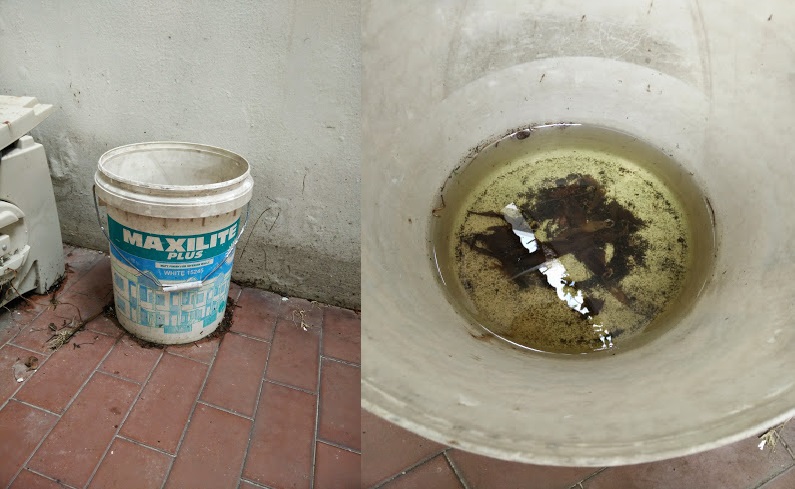
Another constantly overlooked party contributing to mosquito breeding grounds are litterers. Other than being a donkey’s grave, litterers also contribute to the Dengue problem as cups, cans and bottles also end up collecting water after rain.
So what can we do about this? Good ol’ fashioned housework and gotong-royong.
9. Hah? Ask us go gotong-royong? You think this is 1994 izzit? Useless government! Stupid CILISOS!
Yes it’s sooooooo 1994, but organizing a group to clean up your neighborhood sooooooo works; and we can tell you exactly why- by getting rid of mosquito breeding grounds, mosquitoes can’t breed, and therefore less Dengue cases. No science, no fancy equations, just logic and elbow grease.
In a paraphrased summary by Prof. Sazaly and echoed in a separate conversation with Tan Sri Vincent Lee (Who inspired this article, BTW), mosquitoes aren’t to blame for our current Dengue problems but it’s so much easier to point the finger at them because it takes away the attention from the actual guilty party – ourselves. (Everything else mentioned after this is ours)
We like seeing fogging exercises being conducted because of that false sense of security that it gives and placing hope in some “wonder vaccine” or “mutant mosquito” so that we don’t have to be responsible for anything ourselves. And if all else fails, we blame the government.
In this case though, we’re supporting the government and everyone else can go fog themselves.
No really, you can get a private firm to fog your house for about RM150. We checked.
- 560Shares
- Facebook545
- Email1
- WhatsApp2






